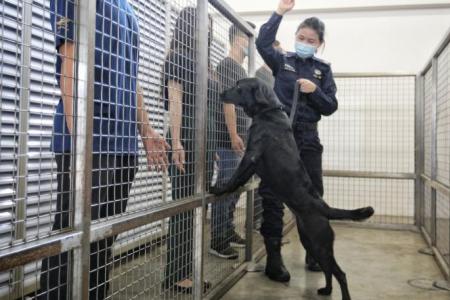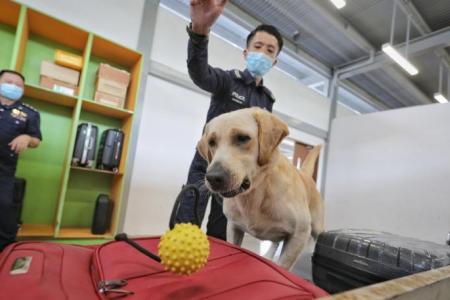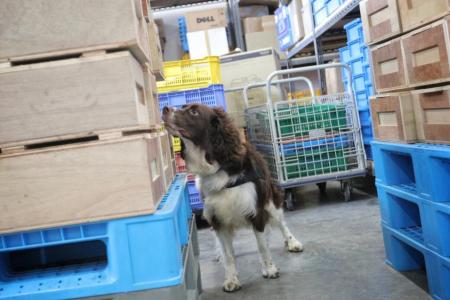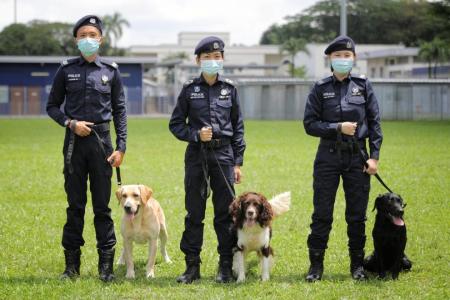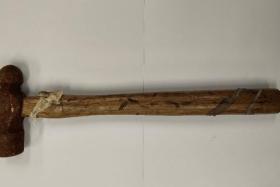Police K-9 dogs do their part to keep Singapore safe and drug-free
Separated from a line of people by a cross-wired metal fence, Dash makes her way from one end to the other, sniffing at each person.
She knows this routine like the back of her paw. The five-year-old labrador retriever has been working as a narcotic detection dog for three years.
Standing on her hind legs with front limbs perched on the fence, Dash takes a long pause before a woman with a bag of drugs planted in her pocket, before turning to look at her handler, Sergeant Choi Jia Wen.
Dash was among three members of the Police K-9 unit which gave The Straits Times a preview of the training for sniffer dogs on Thursday (March 24).
The unit, made up of 240 dogs, is one of the three main tactical units under the Special Operations Command and plays an important role in keeping the country safe, said the Singapore Police Force.
The unit had been involved in around 100 successful cases annually for the past three years.
One case involved Dash, which detected drugs below the driver's seat and arm rest of a car on Bukit Timah Road in October 2020. The police subsequently recovered 32 bags of substances believed to be controlled drugs.
Sniffing dogs like Dash are trained to detect drugs and explosives, as well as human scent, blood and decomposed human remains to aid in police operations.
Before they are deployed at the front line, the dogs have to go through a 12-week training programme with their handlers.
The operations officer of the Police K-9 Unit, Superintendent of Police Tan Khoon Seng, said: "The training process is incredibly important because it strengthens the bond between the handler and dog under his or her charge."
Training rooms are designed to be like places where the dogs are often dispatched to, such as border checkpoints in Singapore.
In a training room, narcotic detection dog Inca walked on a moving conveyor belt, led by his handler Sergeant Aloysius Ho. After getting a whiff of a piece of luggage containing a small bag of drugs, the three-year-old labrador retriever stopped in his tracks.
Next door, explosives detection dog Koby weaved through a simulated warehouse filled with wooden crates and cartons. The English springer spaniel halted before a crate in which a can of explosives had been hidden.
Their handlers then handed them a toy - a ball attached to a string - which they caught enthusiastically.
The sniffer dogs are trained to associate the smell of substances with rewards such as tennis balls. This method of training makes the dogs more likely to repeat behaviours, such as freezing after identifying these scents, said the police force.
The K-9 unit also includes police patrol dogs and security dogs which assist in maintaining public order and safety.
K-9 dogs join the unit when they are a year old and perform duties with one handler throughout their service. The bond between the pair translates to higher operational effectiveness at the front line, said Supt Tan.
Sgt Choi said she spends 48 hours a week at work with Dash, as they prepare to be dispatched for assigments.
"Out of work, (Dash) is also my playmate and friend," she said.
Dog handlers are trained to be proficient, and are able to identify ailments and conduct first aid on their canine colleagues.
Station Inspector See Toh Wai Leng said she bonds with her partner, Koby, through activities such as grooming and exercising.
She said: "The process of training a dog is like raising a child. It takes a lot of time, patience and dedication. But the satisfaction you get from transforming an untrained dog into an operational dog is priceless."
Get The New Paper on your phone with the free TNP app. Download from the Apple App Store or Google Play Store now

